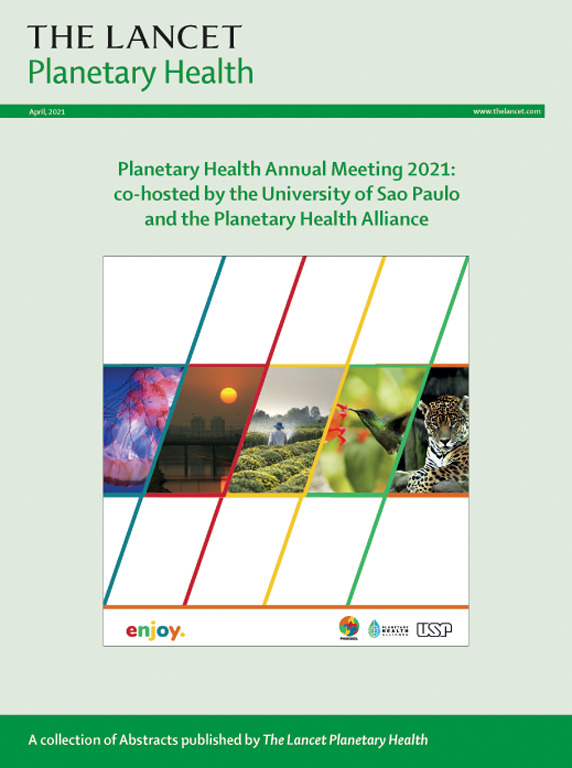Effects of fine particulate matter from wildfire and non-wildfire sources on emergency-department visits in people who were housed and unhoused in San Diego County (CA, USA) during 2012–20: a time-stratified case–crossover study
IF 24.1
1区 医学
Q1 ENVIRONMENTAL SCIENCES
引用次数: 0
Abstract
Background
Being unhoused can increase vulnerability to adverse health effects due to air pollution. We aimed to quantify changes in emergency-department visits during and after exposure to wildfire-specific and non-wildfire particulate matter 2·5 μm or less in diameter (PM2·5) in San Diego County (CA, USA) in people who were both unhoused and housed.
Methods
For this time-stratified case–crossover study, we used data on exposure to wildfire-specific PM2·5 in California and individual-level data for people admitted to the emergency departments of two hospitals (UC San Diego Health emergency departments at La Jolla and Hillcrest, San Diego) in San Diego County between July 1, 2012, and Dec 31, 2020. People with a postcode outside of San Diego County were excluded. Demographic information was age group, race or ethnicity, and transport to the emergency department. Wildfire-specific PM2·5 concentration at the postcode level was previously estimated using an ensemble model that combined multiple machine-learning algorithms and explanatory variables obtained via data on 24-h mean PM2·5 concentrations from the US Environmental Protection Agency Air Quality System. Conditional logistic regression models were applied, adjusting for specific humidity, wind velocity, and maximum temperature extracted from the US Gridded Surface Meteorological Dataset. Housing status was established by registration staff or triage nurses on arrival at the emergency department. For people who were unhoused, exposure was defined based on the weighted mean PM2·5 concentration at the city level proportional to the number of people who were unhoused in each specific city across urban centres in San Diego County. For people who were housed, we used residence postcode to measure exposure. We assessed the association between PM2·5 from wildfire and non-wildfire sources and emergency-department visits in people who were housed and unhoused.
Findings
There were 587 562 emergency-department visits at the two hospitals, 76 407 (13·0%) of which were by people who were unhoused. People who were housed had a higher exposure to overall PM2·5 (24-h mean over the study period of 9·904 mg/m3, SD 3·445) and non-wildfire PM2·5 (9·663, 2·977) than people who were unhoused (9·863, 3·221; 9·557, 2·599). However, people who were unhoused had a higher exposure to wildfire-specific PM2·5 (0·305, 1·797) than people who were housed (0·240, 1·690). Overall PM2·5 exposure was associated with increased odds of emergency-department visits for both people who were housed (odds ratio 1·003, 95% CI 1·001–1·004 per 1 μg/m3 PM2·5 for 0–3 days after exposure) and people who were unhoused (1·004, 1·000–1·008 for 0–3 days after exposure). We found that non-wildfire PM2·5 was associated with emergency-department visits among people who were housed (1·003, 1·002–1·005 for 0–3 days after exposure) and wildfire-specific PM2·5 was associated with emergency-department visits in people who were unhoused (1·006, 1·001–1·011 for 0–3 days after exposure).
Interpretation
People who were unhoused in San Diego County were more likely to visit emergency departments after exposure to increased wildfire-specific PM2·5. As the intensity and frequency of wildfires increase, understanding risk factors for vulnerable populations, such as people who are unhoused, is crucial to develop effective adaptation strategies.
Funding
US National Institutes of Health, National Institute on Aging.
2012-20 年间美国加利福尼亚州圣迭戈县野火和非野火来源的细颗粒物对有房和无房人群急诊就诊的影响:一项时间分层病例交叉研究
背景无家可归会使人们更容易受到空气污染对健康造成的不利影响。我们的目的是量化在圣地亚哥县(美国加利福尼亚州)暴露于直径为 2-5 μm 或更小的野火特异性和非野火颗粒物(PM2-5)期间和之后,无房和有房人群的急诊就诊率的变化。方法在这项时间分层病例交叉研究中,我们使用了加利福尼亚州野火特异性 PM2-5 暴露数据,以及 2012 年 7 月 1 日至 2020 年 12 月 31 日期间圣地亚哥县两家医院(加州大学圣地亚哥分校位于圣地亚哥拉霍亚和希尔克雷斯特的卫生急诊科)急诊科住院患者的个人数据。不包括邮编不在圣地亚哥县的人。人口统计学信息包括年龄组、种族或民族以及前往急诊科的交通情况。之前曾使用一个集合模型估算了邮编级别的特定野火 PM2-5 浓度,该模型结合了多种机器学习算法和从美国环境保护局空气质量系统中获得的 24 小时 PM2-5 平均浓度数据解释变量。采用条件逻辑回归模型,对从美国网格化地表气象数据集提取的特定湿度、风速和最高温度进行调整。住房状况由到达急诊科的登记人员或分诊护士确定。对于无住房者,根据城市一级的加权平均PM2-5浓度来定义其暴露量,该浓度与圣地亚哥县各城市中心每个特定城市的无住房者人数成正比。对于有住房的人,我们使用居住地的邮政编码来测量暴露量。我们评估了野火和非野火来源产生的PM2-5与有房者和无房者急诊就诊之间的关系。与无住房者(9-863,3-221;9-557,2-599)相比,有住房者暴露于总体 PM2-5(研究期间 24 小时平均值为 9-904 mg/m3,SD 3-445)和非野火 PM2-5(9-663,2-977)的程度更高。然而,与有房者(0-240,1-690)相比,无房者的野火特定 PM2-5 暴露量更高(0-305,1-797)。总体PM2-5暴露与有住房者(暴露后0-3天内每1微克/立方米PM2-5的几率比为1-003,95% CI为1-001-1-004)和无住房者(暴露后0-3天内每1微克/立方米PM2-5的几率比为1-004,1-000-1-008)的急诊就诊几率增加有关。我们发现,在有住房的人群中,非野火PM2-5与急诊就诊相关(1-003,暴露后0-3天为1-002-1-005),而在无住房的人群中,野火特异性PM2-5与急诊就诊相关(1-006,暴露后0-3天为1-001-1-011)。随着野火强度和频率的增加,了解弱势群体(如无住房者)的风险因素对于制定有效的适应策略至关重要。
本文章由计算机程序翻译,如有差异,请以英文原文为准。
求助全文
约1分钟内获得全文
求助全文
来源期刊

Lancet Planetary Health
Multiple-
CiteScore
28.40
自引率
2.30%
发文量
272
审稿时长
8 weeks
期刊介绍:
The Lancet Planetary Health is a gold Open Access journal dedicated to investigating and addressing the multifaceted determinants of healthy human civilizations and their impact on natural systems. Positioned as a key player in sustainable development, the journal covers a broad, interdisciplinary scope, encompassing areas such as poverty, nutrition, gender equity, water and sanitation, energy, economic growth, industrialization, inequality, urbanization, human consumption and production, climate change, ocean health, land use, peace, and justice.
With a commitment to publishing high-quality research, comment, and correspondence, it aims to be the leading journal for sustainable development in the face of unprecedented dangers and threats.
 求助内容:
求助内容: 应助结果提醒方式:
应助结果提醒方式:


